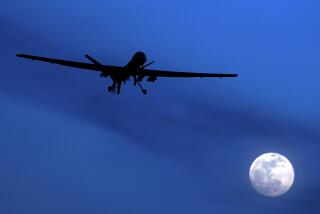Military Considers Using Nonlethal Weapons
- Share via
STATE COLLEGE, Pa. — Imagine a world where land mines don’t blow up but give off an eerie sound that makes intruders feel sick. Or a war where attackers don’t use missiles to stop tanks, but microwaves to shut down engines.
Weapons that don’t kill? They are set to become a greater part of a soldier’s arsenal with the end of the Cold War and the rise of efforts in Somalia and Haiti that don’t come under traditional military duties.
“We’ve been calling on the military to go into other areas of the world and accomplish other missions. We need to give them the new tools to accomplish those missions,” said Edward Liszka, director of the new Institute for Non-Lethal Defense Technologies at Penn State University.
Liszka said high-tech benign weapons could be in use within five years, though they won’t make conventional weapons obsolete. First, more study is needed.
The Marines, who helped inaugurate the institute recently, will finance research and use experts at the institute to serve as “trusted advisors” to evaluate weapons developed by outside companies.
“There is a great deal we don’t know about nonlethal technology, not only the utility of various devices and technologies, but also the legal, ethical, medical and other implications of their use,” said Gen. Michael J. Williams of the Marine Corps Systems Command. “That’s why our new relationship is so vital and will become a powerful force as the Marine Corps enters the 21st century.”
Low-tech versions are already in use--rubber bullets, pepper spray and the like, whether during the humanitarian U.S. mission in Somalia or in Israel’s struggles in the West Bank and Gaza.
It’s a multidisciplinary approach: Legal scholars will determine if the new weapons are lawful, political scientists will consider the diplomatic outcomes, meteorologists will assess the impact on the environment, and doctors will consider the victims.
A nonlethal land mine could be available for use within three years. Another proposal would include a rising barrier to keep invaders out--or surround intruders. And one would use low-level sound waves to create the nauseating sensation of being on a boat in heavy seas.
About 125 million land mines are spread on former battlefields around the world, killing more than 26,000 people every year. Efforts to ban the mines drew the support of the late Princess Diana and won this year’s Nobel Peace Prize.
Researchers also want to find new ways to stop cars and trucks without shooting tires or launching explosives. One weapon might focus microwaves or high-powered acoustics into the engine to stop it. Another system could inject special chemicals that stop the engine.
“We need help. We want a choice on the battlefield,” Williams said.
More to Read
Sign up for Essential California
The most important California stories and recommendations in your inbox every morning.
You may occasionally receive promotional content from the Los Angeles Times.










